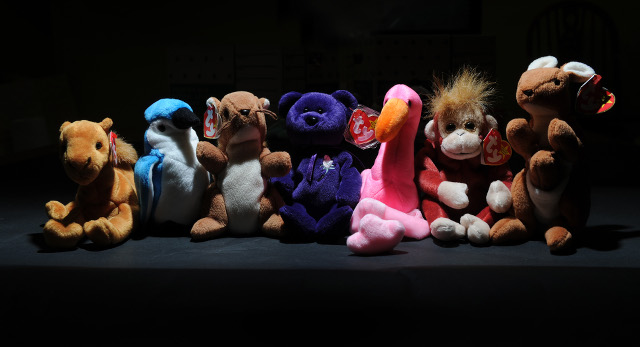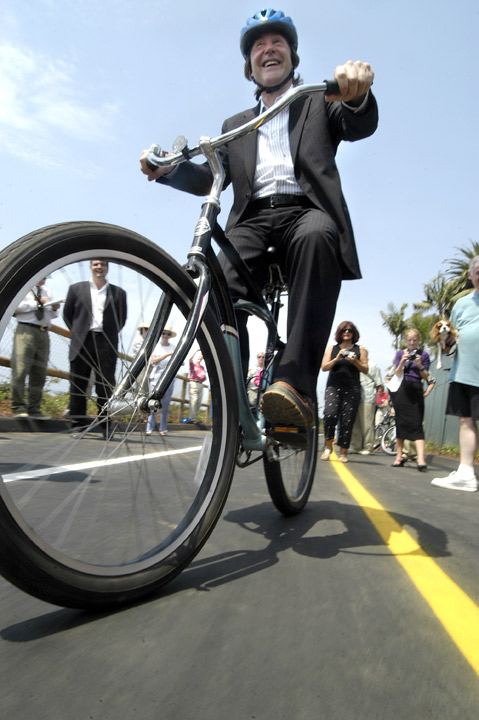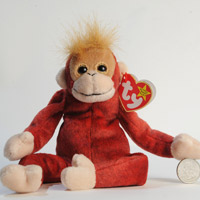Spilling the Beans on Ty Warner’s Toys and Troubles
New Book Explores Mysterious Montecito Mogul and His Stuffed Animal Craze

A few weeks ago, H. Ty Warner walked into Your Remnant Store in downtown Santa Barbara. The small shop’s new owners and their weekend customers snapped to attention.
There was no entourage or security detail, just a quiet, 70-year-old toymaker obsessed with fabric. But he commanded a presence available only to titans of industry who’ve cultivated their wealth as carefully as their mystique. When he was young, Warner, now worth more than $2.5 billion, read a biography of Howard Hughes and decided he wanted to earn and live like the reclusive tycoon.
As he sifted through bolts of paisley and plush with the same perfectionist scrutiny he gave to the Beanie Babies that made him rich — maybe this time choosing upholstery for the Montecito hotels he owns and sometimes micromanages, or the nearby $200 million estate he routinely remodels — Warner was approached by Hillary Hauser.
Hauser shook his hand and thanked him for giving so generously to Heal the Ocean, her environmental nonprofit. Motivated either by a true desire to protect Santa Barbara’s waters or by a more self-serving need for public support as he fought for development permits, Warner had donated to Heal the Ocean more than once in some of his few acts of philanthropy on the South Coast.
Warner was friendly to Hauser in return but kept the conversation brief. He explained he had to “check with his wife” before buying anything. Warner then continued down the narrow aisles, gently feeling samples between his thumb and forefinger and squinting at price tags through tortoiseshell glasses. Soon after, he would stop by the Biltmore Hotel he bought for $150 million to personally check on the gift-shop display of his newer Beanie Boo line.
The downtown errand was unremarkable in a lot of ways. But it was curious and illustrative in others. It proves old habits die hard, that the image of Warner agonizing over fabric swatches as he created his first Beanie Babies in 1993 hasn’t completely faded from reality. It shows the man, notoriously tightfisted as head of what’s still the biggest plush-toy company in the world — and who also owns the Coral Casino, San Ysidro Ranch, Sandpiper Golf Course, and the Montecito Country Club — still can’t pass up a good deal. And it raises some gossipy questions about his personal life because he has a strange habit of referring to his girlfriends as his wives when he’s never been married.
While Montecito’s Willy Wonka of stuffed animals spends more time away from his Chicago home and in his South Coast mansion, a long-awaited book published this month offers mesmerizing insight into his life, his business, and his role in the speculative hysteria of the Beanie Baby boom and bust that 20 years ago mutated a harmless kids’ toy into an overwrought currency of gullibility and greed.

Stuffed with Curiosity
In The Great Beanie Baby Bubble: Mass Delusion and the Dark Side of Cute, Zac Bissonnette gets to the bottom of how consumer psychology and market anomalies conspired to persuade otherwise sane people that buying $5 beanbags mass-produced in China for $10,000 each would be a smart investment. He started researching the book during his junior year in college in 2010 as the country was emerging from the collapsed housing bubble. Already a New York Times best-selling author, he’s written two other financial books.
Bissonnette traces the Beanie fad from its beginnings among Chicago homemakers to its peak when the toys accounted for 10 percent of all eBay sales. He includes early stories of collectors pulling in hefty sums with rare and “retired” Beanie Babies, and how others too late to the game blew their kids’ college savings on a product that’s now practically worthless.
One chapter talks of a man driven to murder over a Beanie deal gone bad. Another describes a North Carolina father and daughter who still live among thousands of plush fish, lizards, unicorns, and bears with a plan to one day open a Ty Inc. museum attached to a McDonald’s.

Looking back, many of the Beanie acolytes remember the thrill of the hunt, the gambler’s high they chased as they waited in long lines and camped out at stores to grab the next “valuable” piece. Few could accept the inevitably of the 2000 crash from oversaturation, bad business moves, and new hot toys like Pokémon and Magic cards.
Perhaps most remarkable is what Bissonnette discovered about the genesis of the little animals and the tricks Warner and his company pulled to create buzz and demand. A brilliant salesman totally consumed with creating the perfect toy — “Even perfection has room for improvement,” he would say — Warner had the simple but inspired idea to move away from traditionally rigid stuffed animals and make something more floppy and cuddly. He then put plastic pellets in his under-stuffed handiwork to make them “poseable,” which gave them more personality and an undeniable charm that spoke to children.
The rarity phenomenon arose partly from Warner’s excessive nit-picking. Whole batches of Beanies would be released then quickly recalled because the boss would find something he wanted to change, whether it was a color, a fabric, or a stitch. Those that did make it to the shelves immediately became collector’s items, their heart-shaped tags encased in plastic protectors and the animals locked in Lucite containers well out of the reach of children.

The “buy now or never” scheme was also cultivated by an ever-changing product line — called a “rolling mix,” Bissonnette explains — to keep consumers guessing and always hungry for more. Cryptic riddles about upcoming “retirements” posted on Ty Inc.’s website only added to the furor.
But before he dives into the nuances of Ty Inc.’s commercial strategies and how a ticking time bomb of a secondary market was fueled by amateur trade magazines, rumor mills, an overexcited media, and the rise of the Internet, Bissonnette takes a hard look at Warner himself.
It was tricky to get a clear portrait. Warner hasn’t granted an interview since a 1996 sit-down with People magazine when he fed the reporter a bunch of half-truths. He wouldn’t talk to Bissonnette (his reps didn’t respond to this paper, either), so the author spoke with former Ty Inc. executives, sales staff, retailers, family, and friends, to the extent Warner has friends.
Warner — named after the great and famously mean Detroit baseball player Ty Cobb — is painted on one hand as a lonesome, sensitive misfit racked by the lifelong pain of a horribly dysfunctional childhood. The word “sad” comes up often. Though he grew up in an upper-middle-class Chicago suburb, Warner’s parents did not create a cheerful household, Bissonnette found.
Much was made of the “unhappy” upbringing Warner’s lawyers obliquely referred to last year in his $100 million tax-evasion case. Critics claimed the admission was just a hollow sympathy play as his attorneys successfully argued Warner’s sentence down from prison time to a $53.5 million civil penalty, community service, and probation.
Yet Bissonnette writes about how Warner’s mother suffered from paranoid schizophrenia. His sister, Joy, reportedly awoke one night to see their mom hovering over her with a butcher’s knife. Warner and his father, who gave Ty his start in the toy industry after he dropped out of college, often dated the same women. Joy confided in Bissonnette that her father repeatedly molested her.
“I truly believe that he has the heart of a kid who was harmed by his mom’s psycho crap,” a former Ty Inc. executive told Bissonnette. “That’s where I always thought that he had a soft spot. He never really had a childhood. He’s got that, like, Michael Jackson syndrome. He’s a really sensitive guy, but he’s got so much damage.” Similar to Jackson, Warner has undergone countless plastic surgeries that have rendered his face taut and doll-like. He styles his hair in a sort of mullet to hide his many incision scars.
On the other hand, and in objective terms, Warner also comes across in the book as a selfish, arrogant tyrant. While he treated his lower-level employees fairly well — Bissonnette writes about how, in 1998, Warner gave all his workers Christmas bonuses equal to their annual salaries —��he was borderline cruel to some of Ty Inc.’s higher-ups and other people he did business with. He allegedly took credit for ideas that weren’t his and work he never did.
And his personal life is littered with broken relationships and estrangements as he valued an opulent existence above all else. In 1996, the same year Warner squirreled $100 million overseas and away from the IRS, he went back on a promise to build his sister a much-needed $100,000 home because he “couldn’t afford it,” Bissonnette wrote. He also declined to help her with her hip surgery, “instead advising her to turn to the seven children she’d raised with a former husband, none of whom Warner had ever met.”
Through all his research and writing, however, Bissonnette never took a dim view of one of the richest men in America. “I couldn’t tell if it was Stockholm syndrome for me, but I absolutely view him as a spectacular talent,” Bissonnette told me last week. “I see him as sympathetic, and I certainly don’t have any negative feelings toward him.”
In an hour-long conversation, Bissonnette, who works at a hedge-fund research firm in New York, talked about how he got hooked on the Beanie topic, why he’s so interested in speculative bubbles, what he thinks about Warner’s court case and real estate investments, and if he’s concerned about getting sued. Here’s an edited version of our talk:
As you know, Ty Warner and his legal team are super litigious. Worried? I’ve gotten no indication that Ty cares at all about the book. And that was true while I was working on it. I got one very nice letter from his lawyer telling me that Ty was very protective of trade secrets, and that’s why they enforce their nondisclosure [agreements]. And they said while they had no reason to think I was seeking trade secrets, I should know employees might not want to talk to me because of that, and I should understand that. That was the only communication of any substance I had with them.
Why chase down the Beanie Baby story? It was really about trying to understand what the process was — to the extent you can ever understand these things — behind how people came to view these beanbag animals as an investment. And how the hell people would have possibly thought they were going to go up in value. People ask, why did the Beanie Baby craze crash? Because it was stupid. Then there’s the elaborate story people string together to make themselves feel better. The book is really a window into speculative bubbles because I’ve always been obsessed with them.
How come? I think the idea of a mass hysteria, even outside of the financial space, is fascinating — how does something like the rise of Hitler happen? These crowd madnesses of people collectively losing their minds are just incredible. Then it was trying to comprehend why it specifically happened with Beanie Babies. Because people point to Cabbage Patch Kids and other products and say, “Who knows why anything happens?” But no, there were a bunch of things about Beanie Babies that really were different.
Do you see any toys or products now and think to yourself, “Jesus, this could be the next Beanie Baby”? The thing that jumps out at me is Bitcoin, in that you had all this interest being fueled by the run-up. And that really is the definition of when something becomes a bubble. Robert Shiller has written a spectacular book called Irrational Exuberance, where he defines a speculative bubble as a time when people are essentially lured in by the stories of other people making money. And the Beanie Babies were 1,000 percent that. That’s what it was. It was these stories of Peanut the Royal Blue Elephant selling for $4,000.
As a member of the media, I was particularly interested and freaked out by how those reports — and I know many of them weren’t accurate — played a big part in starting the craze. Yes! Speculative bubbles don’t start happening until there’s a media. But in terms of anything like that happening now with toys, I think in a way — and people in the toy industry have told me this — that the Beanie craze was so huge and exploded so spectacularly that it will be hard for anything like that to happen again for two reasons.

First, I think people will see the comparison and say, “I’m not falling for that again.” Second, Beanie Babies really gained critical mass before eBay. And now that you have markets that are so connected, it’s hard for stuff to seem rare when it isn’t. There will be micro versions of it among collectors — Build-A-Bears and My Little Ponies sell for inflated prices — but I don’t think there will be another consumer product that everyone hoards for investment and that turns someone into a billionaire.
When you talked to people who were sucked into the Beanie whirlpool, and they looked back on those years, they seemed to have little insight on why they bought into the rage. They had a hard time self-analyzing. What did you make of that? At first, this frustrated me endlessly. And then I realized, “Wait, this is interesting, too.” You’re never going to have a satisfying explanation for why someone did something completely insane, because you’re talking about something that’s divorced from rational thought. I also thought it was interesting that most people bought their Beanies for the $5 retail price and hoarded them because they thought they were getting in on the ground floor.
Of all the stories you heard, which one did you think was most emblematic of an innocent toy getting co-opted into something ugly? The one that struck me most was about psychotherapist Nancy Biank. She helped kids whose parents were dying of cancer, and she would give them Beanie Babies for comfort, which they absolutely loved. She also let them take one home at the end of the program. But once the speculative market took off, the kids started coming to their last therapy sessions with instructions from their parents to take a certain Beanie because they thought it’d be worth something. It started lots of arguments, and she had to stop using the Beanies for therapy.

What anecdote did you think was most emblematic of Warner? I love business stories, and I find the rise much more interesting — the early days. Once someone’s rich, it becomes dramatically less interesting for me. To me, the story of Ty and [his former girlfriend] Patricia Roche sewing the stuffing into the bellies of plush animals on the floor of his condo while Ty’s mother is screaming at her, “You’re a whore! You’re so ugly, and that’s why my son will never marry you!” and Ty just sewing, sewing, sewing away. That ability to focus.
In the book, you talk about his odd behavior, like how he’ll make loud, nasty comments about overweight people near him. Did you hear those kinds of things a lot? We could sit and talk about Ty’s eccentricities all day. He knows the serial numbers of hundreds of lightbulbs. When he was a salesman, he would go from hotel to hotel asking for discounts on rooms they weren’t renting. And he would have these incredible ideas for his hotels or office or house, but he would execute it and then rip the whole thing out. He did that over and over again.
Also, he wanted a different ceramic pig for every cottage at the San Ysidro Ranch, so as he traveled around the world, he would collect the pigs and bring them there. That’s the stuff that makes me think, “Man, you are trying so hard to be a freak.” There is an element of that with him, I think. Like, to what extent is he in on the joke? I think 40 percent.

What did you learn about his real estate investments in Santa Barbara? Ty doesn’t have an MBA or anything. He isn’t a sophisticated finance guy, and he’s not particularly trustful of the stock market, so he sort of just buys what he likes. He wanted those big, marquee properties, and he sometimes bought them even when the numbers didn’t make any sense. It’s like buying sports teams. It isn’t really about the cash flow year to year. It’s about making sure you have [a property] conservatively financed enough that you’re not going to lose it. And at some point when you want to sell it, there will be someone else who will pay you more than it’s technically worth because there are only so many properties like it.
What’s your take on his legal issues, and what did you think about federal prosecutors appealing his probation sentence? Do you think he deserves prison time? I thought his whole case was BS. This was suave UBS bankers [from Switzerland] going to this newly rich college dropout and telling him, “Park this money over here. This is a good idea.” Then finally the U.S. government catches on to UBS, and to avoid being fined, UBS hands over the names of all the clients it promised confidentiality to. The real bad guys here are UBS, I think. Obviously you should pay your taxes, but at the time a lot of people were doing it. I thought it was a little bit of a tempest in a teapot.
I really, really hope they don’t put him in prison. I know a lot of people do, but I don’t. I don’t think he deserves it. Ty would be like one of two or three people in the thousands of people who had these Swiss accounts who would end up in prison. He’s already part of the 1 percent who were indicted.
By the way, I’ve heard he’s done just incredible things with his community service. He’s been very, very good with kids and not mailing it in at all. He’s taking it as an opportunity to do some real good.
I’m going to ask you to speculate here: What do you think Ty Warner wants his legacy to be? I think he wants to be the greatest toy salesman there ever was, and I think he is. As someone once told me, “Ty’s real talent was an ability to take crap and convince people it was really important.”
Live and Let Live
Last summer, Ty Warner’s name was wiped from the side of the Sea Center on Stearns Wharf in the midst of his tax-evasion case and a Santa Barbara Museum of Natural History “rebranding.” He had given the aquarium on the wharf $1.5 million in 2005. Before that, grumblings arose over access to a bike path near his estate, the gates of which he painted gold the day after his probation was handed down, and his doomed ownership of the Miramar Hotel didn’t sit well with neighbors. His sometimes sour reputation took another hit this month when he cancelled his San Ysidro Ranch advertising in the Montecito Journal after it ran a short column about Bissonnette’s book.
But like Hillary Hauser, many on the South Coast are simply appreciative of the generosity Warner has doled out over the years and are content to just let him be. It’s his life and his money, they declare. Who’s anyone to say what he does with either?
J’Amy Brown, a longtime Montecito watchdog and planning commissioner, is one of the few people around who’s spent any significant time with Warner. They met at the Santa Monica Beach Club shortly after he bought the Coral Casino to discuss the style and sensibilities of a high-end coastal operation and how they might align with his vision for the property. Brown said she found him “quite charming” and “well-bred.” A string of his employees followed them as they talked and wrote down every word he said.
But he had a sense of isolation about him, Brown went on, and she hasn’t said hello to him in public since so as not to make him uneasy. A decade ago, when the USS Abraham Lincoln parked off the coast, Warner handed out nautical-themed Beanie Babies to some of the visitors. Brown said she could sense his discomfort from afar as he slowly backed away from the crowd.

In 2001, Warner created an exclusive line of 588 Beanie bears for members of the Coral Casino. He personally numbered and signed their tags. One recently sold on eBay for $800. The Coral Casino bears are some of the very, very few of the more than 2,000 different species of Beanie Babies, which have all been discontinued, that can fetch any real money today. The vast majority are worth nothing more than their sentimental value and have been forgotten in the backs of garages or donated to thrift stores and children’s hospitals.
When Warner moved to Montecito in 2000 shortly before Oprah did, he helped shift the community’s vibe from relatively circumspect to decidedly extravagant. While that’s enjoyed by some residents, others find themselves muttering, “Montecito — full of shady palms and shady people.” And what happened, they wonder, to the generous Ty Warner who used to help Heal the Ocean?
Tom Modugno has an idea to help Warner erase his public-relations blemishes. A lifelong Goleta resident and the owner of Santa Cruz Markets, he’s working to preserve the old Barnsdall-Rio Grande Gas Station that sits along Hollister Avenue and on the edge of Warner’s Sandpiper Golf Course property. The building is boarded up and fenced off but still sports its ornamented mosaic dome above time-capsuled relics from its heyday in the 1920s.
Modugno wants to see the gas station saved and restored to its former glory and is soliciting the City of Goleta and the Pearl Chase Society to have it designated as a historic landmark. His online petition has nearly 3,000 signatures. But he knows it’s ultimately up to Warner to decide if it will continue to crumble or even be completely torn down. Modugno said he’s so far been unable to reach Warner, who still spends a few months in China every year to oversee Ty Inc. production, and he’s not holding his breath.
But he has a message for the billionaire: “Hey man, you need some good PR, and this is your opportunity. If you waved your little magic Beanie Baby wand and saved this thing, you’d be a hero.”
Rich and Alone
An excerpt from The Great Beanie Baby Bubble:
The last time Warner saw his sister, in the mid-2000s, he took her on a tour of the Montecito, California, estate he was building at a cost of well over $150 million. He showed her the landscaping and Mediterranean architecture, then he led her into the formal dining room with seating for at least 40 people. “And this is where we eat when we have company,” he explained.
“Who would you have over?” Joy asked with an edge she quickly regretted, because she could see that it had hurt him.
He was quiet. Then: “Nobody,” he said coldly. Then he turned and walked into the next room to continue his tour of one of the most expensive homes in America.



